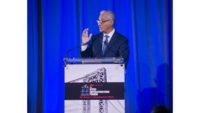
Five years after a fully loaded locomotive and 26 coal cars chugged over a 30-ft-long, 17-ft-wide span comprising eight hybrid composite beams (HCB) in Colorado, the technology has been used in nine states.
An HCB consists of a glass-fiber-reinforced plastic shell with high-strength continuous steel fibers placed along the bottom flange and filled with self-consolidating concrete (ENR 4/12/10 p. 34). Like the Bridge-in-a-Backpack (BIAB)—another non-traditional construction technology largely developed and pioneered in Maine (see p. 12)—HCB aims to provide portability, ease of installation and, ultimately, an extremely long and durable bridge life.
Unlike the BIAB, HCB's patented, proprietary nature means it isn't likely to gain American Association of State Highway and Transportation Officials acceptance into bridge design code as an alternative to standard materials. "The Bridge-in-a-Backpack has a design guide. It's proprietary, but they found a way to generically design it," notes Stacy McMillan, structural liaison engineer, Missouri Dept. of Transportation.
To date, there are 11 permanent HCB installations. West Virginia boasts the longest beams, at 107 ft. Some dozen more projects are slated for construction in Washington state, Maryland, Maine and Canada. Uses include marine piers and LNG terminals, says John Hillman, the inventor of HCB.
Hillman acknowledged the challenge of introducing a proprietary item into the transportation infrastructure world. "It gives you very little market penetration," he says. "Still, we have found a subculture of engineers, owners and contractors that really do like the concept of change."
Aided by funds from the federal Highways for Life program, MoDOT employed HCB on three crossings as part of the state's "Safe and Sound" program, which swiftly replaced or rebuilt 801 bridges and finished last year.
Crews tried three different ways of installation. "You can erect the beam empty, then cast the concrete in place—that gives you the advantage of a lighter girder to erect," says McMillan. "For another, we shipped to the jobsite empty, filled it with concrete in the staging area and then erected it. It was still lighter than a conventional girder. And the third, we had it cast by the fabricator and shipped to us full. All three ways worked out."
McMillan notes that the price of shipping the beams from Maine is costly, especially considering that Missouri has a strong precast-concrete market. Dennis Heckman, MoDOT state bridge engineer, says it would consider using HCB again, but cost is still an issue. "The ease of installation was just as advertised," he says. "The long-term benefits would be no corrosion, [but] that will take some time to show up."



Post a comment to this article
Report Abusive Comment